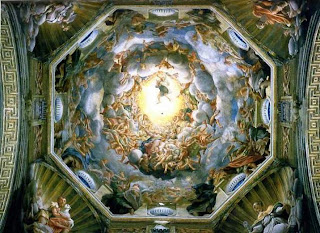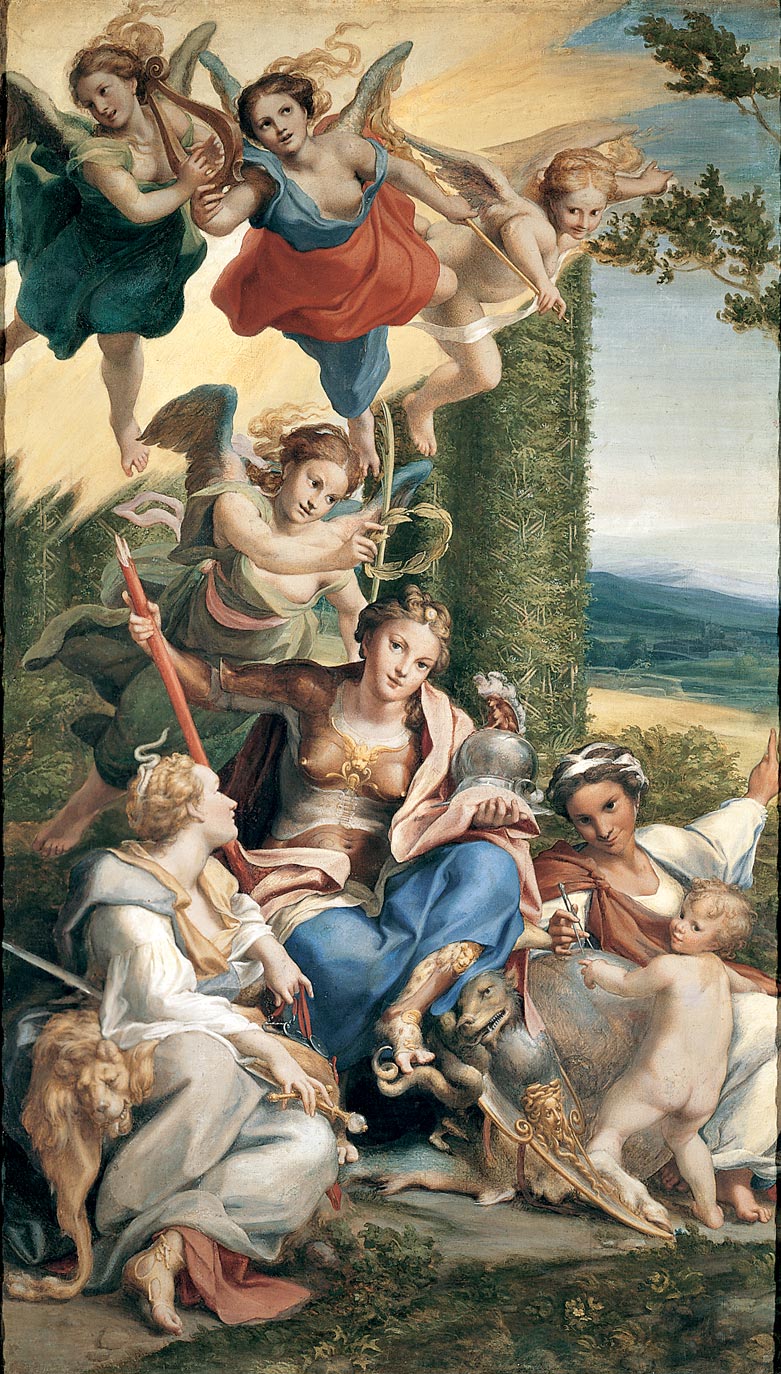Thursday, June 18th, 2009
Correggio as Proto-Baroque
I think that the painter Antonio Allegri (better known as Correggio) deserves more study and placement in art history texts. Even though his painting Jupiter and Io graced the cover of my first art history textbook, he didn’t get a whole lot of discussion in that edition of Art Through the Ages. (BTW, I noticed Jupiter’s face and hand in that painting after owning that textbook for a few years – can you spot them in the cloud?) The subsequent editions of Art Through the Ages seem to mention less and less of Correggio.
 Correggio was a Late Renaissance painter from Parma, Italy. His illusionistic ceilings like Assumption of the Virgin (1526-1530, Parma Cathedral dome; shown right) were a source of inspiration for many Baroque painters who followed in the 17th century. These 17th century artists revered Correggio and considered him and Raphael to be the great Old Masters. Subsequently, Correggio’s works were widely collected; people went to great lengths (ahem, scandalous lengths) to get a hold of his art.1 Although Correggio’s influence on Baroque painters has been mentioned before, I am particularly interested in how Correggio influenced my favorite Baroque sculptor, Bernini.
Correggio was a Late Renaissance painter from Parma, Italy. His illusionistic ceilings like Assumption of the Virgin (1526-1530, Parma Cathedral dome; shown right) were a source of inspiration for many Baroque painters who followed in the 17th century. These 17th century artists revered Correggio and considered him and Raphael to be the great Old Masters. Subsequently, Correggio’s works were widely collected; people went to great lengths (ahem, scandalous lengths) to get a hold of his art.1 Although Correggio’s influence on Baroque painters has been mentioned before, I am particularly interested in how Correggio influenced my favorite Baroque sculptor, Bernini.
So far, I have read two comparisons between Bernini’s work and that of Corregio.2 Bernini’s sculpture Truth Unveiled by Time was influenced by the figure of Minerva in Correggio’s Allegory of Virtue:
 Correggio, Allegory of Virtue (1528-1530), Louvre
Correggio, Allegory of Virtue (1528-1530), Louvre
 Bernini, St. Longinus (1629-38); St. Peter’s Cathedral, Rome
Bernini, St. Longinus (1629-38); St. Peter’s Cathedral, Rome
 Correggio, detail of apostles (1526-30), Parma Cathedral dome
Correggio, detail of apostles (1526-30), Parma Cathedral dome(You can see how St. Longinus’ outstreched arms mimic that of the apostle in the red robe.)
Do you like Correggio? Do you know of any other connections between Correggio and Baroque artists?
1 David Ekserdjian writes, “The Este family of Modena were exceptionally insatiable and unscrupulous: they secretly replaced [Correggio’s] ‘Notte’ by a copy, the discovery of which caused a riot in Reggio Emilia.”. “Correggio.” In Grove Art Online. Oxford Art Online, http://www.oxfordartonline.com.erl.lib.byu.edu/subscriber/article/grove/art/T019595, accessed 19 June 2009.

That's interesting, I didn't know of that connection. Didn't we see his illustionistic ceiling on our trip? We went into SO many churches, I can't recall… And of course, Bernini is also a fave of mine.
We didn't go to Parma on our trip (at least, I don't remember going there). But we did see some illusionistic ceilings on our trip. I specifically remember seeing Pozzo's The Triumph of St. Ignatius Loyola when we were in Rome.
Did you ever get neck-chopped by Ben during our trip? He would always come up and neck-chop the people who were staring up at ceilings and domes. Ha!
It took me a few years to see Jupiter in the cloud on that textbook cover as well. I always thought it was such a strange painting until I actually realized what it was depicting.
I like Correggio, but I really don't know much about him. A lot of these artists that were stylistically before their times often get overlooked, I think, because it's not so easy to pigeonhole them for teaching purposes.
Yeah, Kiersten, I agree. It's hard to discuss Correggio in an art history course (especially a survey course) because his style is so different than the other art produced at the time. Perhaps he would be a good figure for introducing the Southern Baroque style (instead of Late Renaissance) to a class? Hmm.
I'm very struck at how beautiful St. Longinus is. At least, I think it is beautiful.
Oh yeah, I think St. Longinus is beautiful too. There is so much power and strength in his physique and stance (and it makes sense that Bernini would stress that – did you know that he's the saint who pierced Christ with a spear to make sure that He was dead?).
I think everything Bernini did is beautiful.
I didn't know that! I just went and read up on it on wikipedia (as much as one can read up on a subject there). That is so cool.
I'll bet you are the coolest person to go to a museum with.
What I find interesting is that there are three paintings of the Allergory of Virtues attributed to Correggio. He did not commonly do autograph copies but the Scotland National Art Museum (Bargain or Blunder) and the Doria Pamphili museum both have unfinished copies of the origina Virtues now in the Louvre. This is the painting you have your Bernini connection associated with. I don't see it as you do but maybe I need to study it more. 17th century artists commonly depicted the works of Correggio. The Caracci brothers has mutiples of his work (Parmiggiao, Lotto, Artrusi, Maratta, etc.) The Maffai, Gonzaga, Dal Pozo, Colanna and Farnese collections all have major works in their collections as copies after Correggio…including some references to scupture.
Anyway, he was the master of his time but because he did not study in Rome…he was somewhat overlooked in present day but not by the masters of his time. Andrea Del Sarto traveled for 100's of miles to see his works as did some of his contempories. Interesting, he has a depiction of Michangelo in one of his paintings (no one has ever referenced this) which did prove his trip to Rome (long considered as never happened.)
KM
Thanks for your thoughtful comment, Kevin (and welcome to my blog!). You obviously know a lot about Correggio (do you specialize in his art?), and it was interesting to read about the other artists that were influenced by him. I'm not surprised by all of his connections with 17th century artists – it makes sense that his style would influence the Baroque world.
I am especially intrigued by the Correggio/Rome/Michelangelo connection. From what I can tell, Vasari is the person who (incorrectly) wrote that Correggio did not travel to Rome. Do we know if Correggio painted this depiction of Michelangelo when the latter was in Rome? I've tried to find more information about this Michelangelo portrait, but I haven't been able to find anything online. Do you know any more information? Are there any reproductions available online?
Again, thanks for your comment.
Just getting back to this blog! I am not a professional art historian/etc. I have studied Correggio's life as my family owns a painting purchased as a copy after Correggio. It is the Mystic Marriage of St. Catherine (Louvre Version) and is dated to the time period of Correggio by the McCrone Institute (Shroud of Turin fame) The painting came to us through Puebla, Mexico (Martinez de la Hidalga) family formerly of Maestu, Spain. Interesting history to the painting. It may well be the one possibly attributed to Del Sarto as a copy. The only known ancient copy. We tried to trace the painting mentioned in the 1627 Gonzaga sale to Charles I and lost track of it in the early 1800s as it appeared to have been given by George IV to Sir Herbert Taylor, Keeper of St. Katherine's hospital in London in the 1830s.
Mengs argured that Correggio visited Rome and was influenced by the great painters there. His figures suggest a study of sculpture which he surely got in Rome and not Mantua. It was said that the Abbess who commissioned his frescos at the Convent San Paolo sent him to Rome to study prior to painting these. My step-mother identified a figure in one of Correggio's paintings (not a portrait) as a high degree of likeness of Michaelangelo.
Best,
Kevin